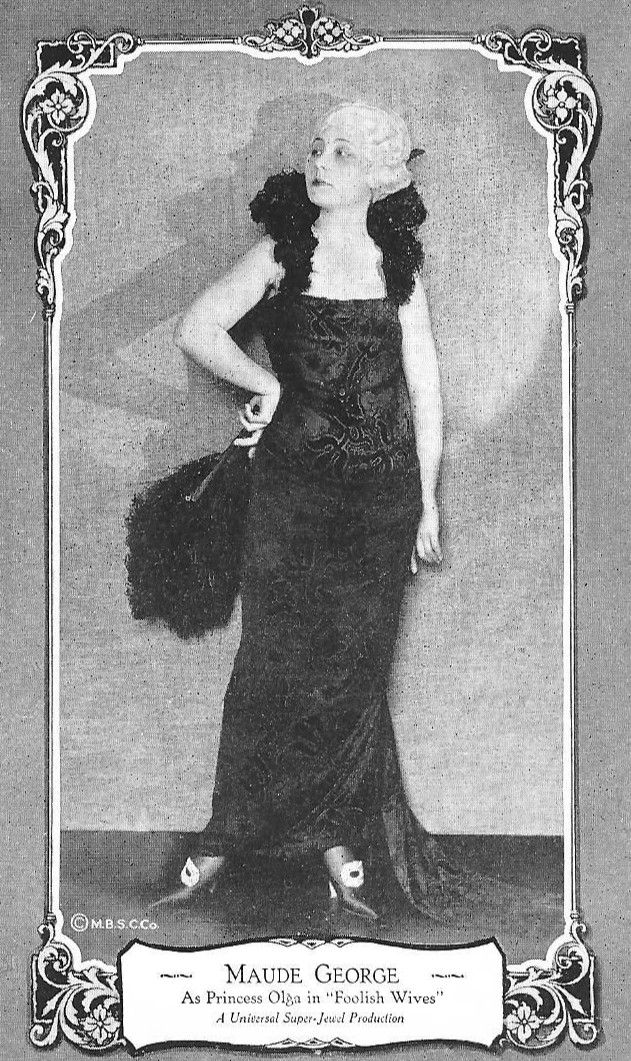1. Overview
Maude George was an American actress of the silent film era, active between 1915 and 1929. Known for her prolific career, she appeared in over 50 films during this period, notably collaborating with acclaimed director Erich von Stroheim on several of his significant works. Beyond her acting contributions, George also ventured into screenwriting, leaving a notable mark on early American cinema as a versatile and enduring presence.
2. Biography
Maude George's career spanned both the legitimate stage and the burgeoning world of silent film, showcasing her versatility as an actress.
2.1. Early Life and Stage Career
Born on August 15, 1888, in Riverside, California, Maude George began her acting journey on the legitimate stage. Early in her career, she toured the United States with a theatrical troupe led by the prominent actor Nat Goodwin. Her family connections also extended to the theater world, as she was the niece of well-known actress Grace George.
2.2. Silent Film Career
George transitioned to the film industry in 1915 and rapidly became a prolific performer, appearing in over 50 films by the end of the silent era in 1929. She is primarily remembered for her consistent work as a member of director Erich von Stroheim's ensemble of actors, featuring in four of his lengthy and notable films throughout the 1920s. These collaborations cemented her reputation as a reliable character actress. In addition to her extensive acting credits, George also contributed to the creative side of filmmaking by writing the scenario for the 1917 film The Fighting Gringo, which starred Harry Carey.

3. Filmography
Maude George appeared in numerous films during her active years in silent cinema. The following is a partial list of her notable acting credits:
- Langdon's Legacy (1916)
- The Silent Battle (1916)
- The Beckoning Trail (1916)
- Idle Wives (1916)
- The Social Buccaneer (1916)
- The People vs. John Doe (1916)
- The Iron Hand (1916)
- Magda (1917)
- The Piper's Price (1917)
- Even As You and I (1917)
- Heart Strings (1917)
- Barbary Sheep (1917) (incomplete, only an 8-minute clip exists)
- 'Blue Blazes' Rawden (1918)
- The Marriage Ring (1918) (lost film)
- The Midnight Stage (1919)
- A Rogue's Romance (1919) (lost film)
- Madame X (1920)
- The Devil's Pass Key (1920) (lost film)
- Roads of Destiny (1921)
- Foolish Wives (1922)
- The Power of a Lie (1922)
- Monte Cristo (1922)
- Merry-Go-Round (1923)
- Temporary Marriage (1923)
- Six Days (1923)
- The Drums of Jeopardy (1923)
- Torment (1924) (lost film)
- Worldly Goods (1924)
- Soiled (1925)
- The Love Toy (1926) (lost film)
- Altars of Desire (1927)
- Isle of Lost Men (1928)
- The Garden of Eden (1928)
- The Wedding March (1928) (lost film)
- After the Storm (1928)
- The Woman from Moscow (1928) (incomplete, only reels 4, 6, and 7 exist)
- The Veiled Woman (1929)
4. Death
Maude George passed away on October 10, 1963, in Sepulveda, California. She was 75 years old at the time of her death.
5. Legacy and Assessment
Maude George's significant contribution to early cinema lies in her prolific output and her consistent work as a character actress. Her involvement in over 50 films during the silent era, particularly her recurring roles in films directed by Erich von Stroheim, demonstrates her enduring presence and reliability in the industry. While specific details about her acting style are less documented, her extensive filmography and association with a director known for detailed characterizations suggest her capacity for nuanced performances within the dramatic conventions of silent film. Her additional credit as a screenwriter for The Fighting Gringo further highlights her multifaceted engagement with the film medium, solidifying her legacy as an important, albeit often unsung, figure in the formative years of American cinema.